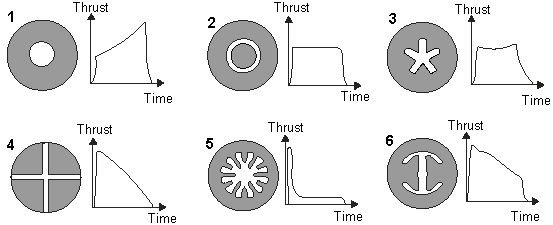Solid cores, either for solid-fueled of hybrid rocket motors, use various propellant grain geometries to achieve thrust curve needed. For example, some of these could look like:

Common solid propellant core cross-sections of grain geometries, including circular, finocyl and non-circular bores.
And there are other profiles in use, such as C-slot (wedge cut out at the side of the core), Moon burner (off-center circular bore), and so on.
But all of these are actually 2-dimensional bores, and it seems reasonable to me that such solid-fueled stages could benefit from a 3-dimensional grain geometry. Depending on the fuel and propellant mixture used (and with hybrid rocket stages that use solid fuels), some of the common ones seem adhesive enough to enable additive manufacturing techniques (a.k.a. 3D printing) to simply print a perfect grain geometry needed for the trust/burn profile.
For example, Ammonium Perchlorate (NH4ClO4 or AP) or Nitrous Oxide (NO) are powerful oxidizers that are often used together with Polybutadiene ((C4H6)n, or PB) groups in HTPB or PBAN mixtures, together with aluminum (Al) powder and curing agents to form fairly homogenous and adhesive solid propellant grain, and with hybrid rockets, the solid cores that seem to be considered the most lately use paraffin wax. All these substances should be fairly straightforward to 3D print with, and could possibly even enable fine-grain control over fuel, oxidizer, binder / curative and catalyst components mixture.
Just to expand a bit on what I had in mind, additive manufacturing with paraffin wax is perfectly feasible since the material allows for thermal manipulation from its liquid to solid phase without chemically destabilizing the fuel's chemistry and degrading its performance. Here's one example complex part made with paraffin additive printing by SLS wax printer:

Solid wax sprocket gear (source: RepRap SLS wax printer Wiki)
It might not be the most detailed print ever, but it would enable advanced grain geometry and potentially increase performance of hybrid rocket motors once the fuel is being depleted and the geometry of the oxidizer path changes, as is demonstrated to be a problem in e.g. High Performance Hybrid Upper Stage Motor (PDF).
I'm not too sure that thermal manipulation could be used to such extent for non-hybrid solid motor grain where oxidizer is already a component of the mixture, but judging by Thermal Degradation of Polyacrylonitrile, Polybutadiene, and Copolymers of Butadiene With Acrylonitrile and Styrene (PDF), PB seems to be thermally stable without degradation beyond its evaporation point at roughly 407 °C. AP's melting point is at 240 °C and Aluminum powder melting point is at 660.4 °C (source).
Of course, thermal manipulation required for additive manufacturing could be limited to temperatures that don't degrade the grain and simply (re)enable their adhesive properties before curing agents are applied and the layer is cooled down to a solid. And I doubt that high precision additive printing at high temperatures would be required to still benefit from a more complex 3D grain geometry than simple 2D and/or 3D geometries by stacking sections one atop the other permit. This might be especially useful for solid fuel grain geometry in hybrid motors, though.
So here's my question:
Has anyone already considered using state-of-the-art additive manufacturing techniques to 3D-print solid core propellants instead of casting them into molds or boring simple 2-dimensional profiles into them?
If yes:
- what performance benefits could be expected from 3D-printed solid / hybrid cores,
- how far have such techniques progressed, and
- who's developing them?
If no:
- what challenges need to be solved to enable manufacturing of 3D-printed solid cores
- which grain geometries could be considered first (honeycomb, bubble, helix, petal, non-homogeneous propellant mixtures,...) that can't be achieved using simple 2D grain geometry techniques (casting, boring,...)?